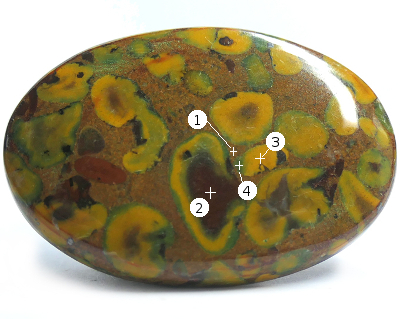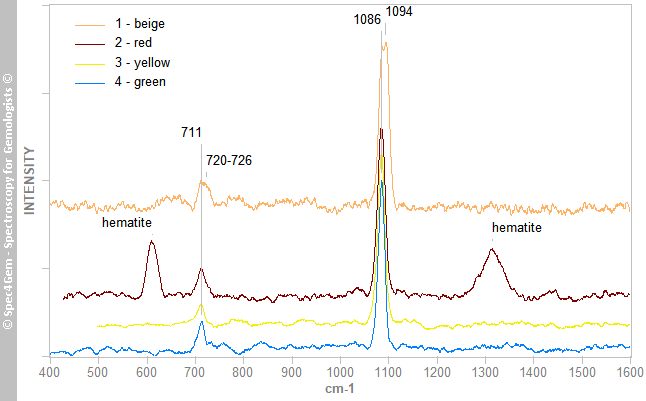Ajooba jasper known as conglomerate or fruit jasper - Sabalgarh marble
- Details
- Created: Thursday, 18 July 2024 12:59
The colorfull gemstone cabochon (Figure 1) shows a particular graphical pattern that looks like pistachio slivers in a cake. Such appearance probably gives the 'fruit jasper' name to this gemstone. Its other name is 'ajooba jasper' deriving of the Urdu word Ujubu with the meaning 'one kind of'. The material is not a new one since it was used in ornamenting the Mogul buildings of Agra. Samples available beginning of the 20th century were quarried in the Gora quarry at Sabalgarh in the Madhyar Pradesh state of India. This locality gave also its name to the ornamental stone: Sabalgarh marble. You have noted that we have two material designations: jasper and marble, Raman spectroscopy will be used to try to answer to this dilemma.
The gemstone is an aggregate of bright red, brown red, green, yellow, orange and kaki 'nodules' in a buff or beige or brown matrix. It looks different of the typical breccia or conglomerate jaspers. This structure has puzzled geologist as to how it formed. It is believed it formed at Silurian age from a heavily altered fossiliferous limestone (Price 2007[1]).
 Figure 1. 56.53 ct Salalgarh marble cabochon found in market as
Figure 1. 56.53 ct Salalgarh marble cabochon found in market asconglomerate jasper, fruit jasper or ajooba (ujuba) jasper.
| Shape | oval cabochon |
| Size | 48.8 x 29.6 x 5.0 mm |
| Color | matrix: brown, beige, nodules: brownish-red, yellow, green, kaki |
| Diaphaneity | opaque |
| Lustre | sub-vitreous |
| Weight | 56.53 ct |
| SG | 2.70 |
| RI | ~ 1.72 |
| DR | - |
| Pleochroism | - |
| Polariscope / Conoscope | - |
| SWUV | inert |
| LWUV | inert |
| Magnetic susceptibility N52 | diamagnetic |
| Chelsea filter | inert |
Table 1. Observational and measured properties
Raman spectroscopy:
Raman spectra (Figure 3) were collected from four distinct spots (Figure 2), the spot #1 in the beige / brown matrix, the spot #2 in the brownish-red nodule, the spot #3 in the yellow nodule and the spot #4 in the green envelope of the yellow nodule. Because of the fine grained material, elastic scattering made a high level background, therefore it was almost impossible to collect spectra below 400 cm-1. All spots yielded the 711 and 1086 cm-1 peaks that characterizes calcite mineral. The spot #1 in the 'matrix' showed two additional peaks that are closed to the calcite ones at 720-726 and 1094 cm-1, these are related to the dolomite even if the 1094 cm-1 is slightly low, the dolomite is usually at 1097 cm-1. The spot #2 in the red showed two additional peaks related to the hematite.
 Figure 2. Spots where the Raman spectra were collected.
Figure 2. Spots where the Raman spectra were collected. Figure 3. Raman spectra of the four spots identified in the Figure 2, all show calcite peaks (711 and 1086
Figure 3. Raman spectra of the four spots identified in the Figure 2, all show calcite peaks (711 and 1086cm-1), matrix (spot #1) shows additional dolomite peaks (720-725 and 1094 cm-1) and the spot #2 in the red shows hematite peaks.
Conclusion:
This ajooba 'jasper' (tradename) is not a jasper (siliceous stone) but a kind of marble with calcite nodules and calcite-dolomite matrix. Whatever its true nature is, such a gemstone shows an lovely graphical and colored pattern.

